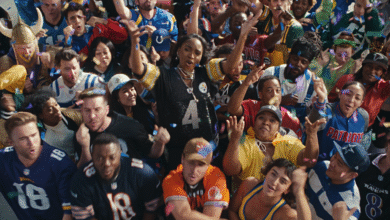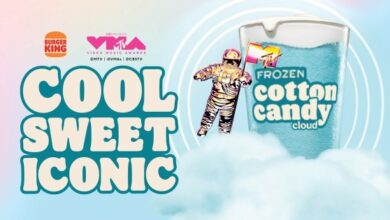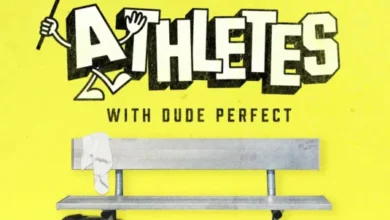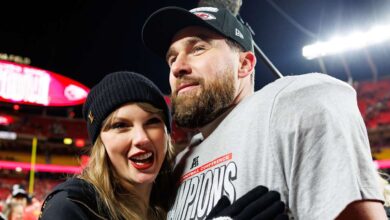Behind the scenes with Tony Romo, Jim Nantz and the NFL’s top broadcasting team
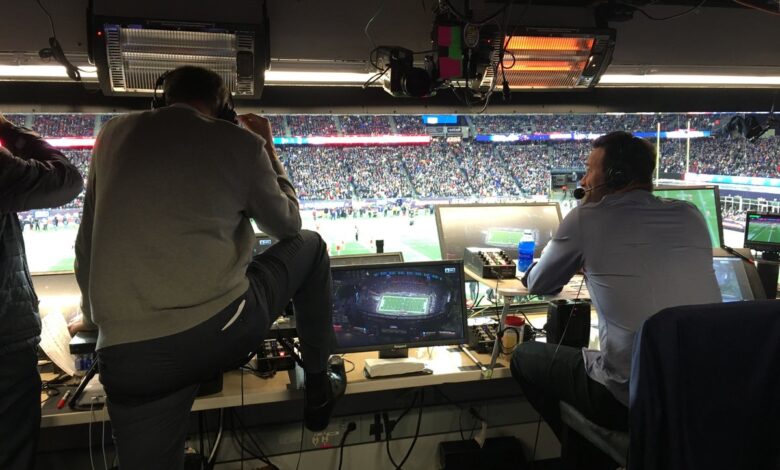
The assignment is far less glamorous than calling a Super Bowl or The Masters but Jim Nantz agrees to take on the responsibility of ordering breakfast at Dunkin’ for our group of five. We are in Providence, first in line at the drive-thru, and Nantz is fighting a nagging cold. His voice is a little off but his body gifted him eight hours of restful sleep and he eagerly orders a pair of egg-and-cheese wake-up wraps and black coffee (with a turbo shot) for himself, as well as various breakfast start-me-ups for the four other passengers. Everyone should get to hear Jim Nantz tell a Dunkin’ attendant, “We’ll have a 25-count Munchkin” at least once in life.
When the car rolls up to the cashier, Nantz apologizes for asking the attendant to break his $100 bill. It’s 11:30 a.m. on a December Sunday in New England. The Patriots and Chiefs meet in less than five hours at Gillette Stadium and for the first time since Nantz, Tony Romo and reporter Tracy Wolfson partnered three seasons ago to form the lead team at CBS on the NFL, the network has agreed to let a reporter embed with the production for a couple of days. It is one of the biggest games of the year for CBS and the audience will ultimately reflect that. Kansas City’s 23-16 victory pulls in 28.11 million viewers, the network’s most-watched Sunday regular-season game in four years.
As we make our way north on I-95 from Providence to Foxborough, still hours before game time and enjoying our on-the-go brunch, the longtime CBS broadcaster explains how valuable this game is to his network.
“This is the game CBS tried to protect in that lobbying period from January 1 to the schedule release,” Nantz says. “People can talk about the lobbyist efforts in Washington; the lobbying efforts that go on between CBS and Fox and other broadcasters trying to get games, I’d like to attend those dinners. This date has been circled for us for a long time, but I don’t approach it any differently. I’m just excited about it as a fan.”
Nantz likes to arrive at game sites early. He enjoys seeing a stadium come alive. After he passes through Gillette Stadium security, he heads straight to the production truck to watch the various NFL pregame shows with lead producer Jim Rikhoff, who has been with CBS Sports since 1985. Rikhoff was named the lead game producer of CBS’ top NFL team in April 2017, around the time Romo was officially announced as the network’s lead NFL game analyst. Most remote productions follow the personality of the lead producer and on-air broadcasters. Rikhoff takes the work very seriously but not himself, and that vibe extends to the group.
Romo doesn’t arrive as early. He woke up at 7 a.m., but fell back asleep to get an extra hour of rest. From his hotel, he FaceTimes with his wife and kids in Dallas and then got in a quick workout. He generally likes to arrive at the stadium about 2½ hours before kickoff. (That’s pretty close to when he would arrive as an NFL player, which was three hours before kickoff). On this Sunday, he arrives a little earlier than usual so he and Nantz can tape a one-minute tease insert for their game into the halftimes of the 1 p.m. ET kickoffs.
Once there, Romo sets up his game notes and gets familiar with the surroundings. Tom Brewer, who is Romo’s editorial assistant and spotter and one of his closest friends dating back to their Eastern Illinois days, pulls out a portable music player. He sets it up next to the television monitors and Romo’s game notes and presses play. On comes U2’s “So Cruel.”
As Romo stands looking out over Gillette Stadium, the song starts and, after a few beats, he begins belting out lyrics. He’s not Pavarotti-loud, but you can hear Romo over Bono at times. After that song comes more: “Radio Ga Ga” and “We Are the Champions” by Queen, and Bruce Springsteen’s “Born To Run.”
It’s not just that Romo loves music. He belts out tunes to warm up his voice. Brewer often joins in. Romo’s favorite song is U2’s “Bad,” but the key U2 song in the mix is “Red Hill Mining Town.” That song is very high in some parts and that’s when Romo knows his voice is ready — if he can hit the high notes on “Red Hill Mining Town.” As Bono hits a high note on the song, Romo and Brewer make a game effort to match it. It’s not exactly Grammy Award-winning but it’s fun to watch. On Sunday, Romo sang for about 45 minutes, eight songs or so, and he really revved it up when Bono went high.
“You caught me on a good day,” Romo says, laughing, proclaiming himself ready for air. “Doing so many practice games a couple of years ago, I realized I always had to warm my voice up to not sound bad. My voice isn’t good anyway so I like to get it as good-bad as I can.”
“I think there are really two parts of the music for Tony,” Brewer says. “One, he just loves music and a little ritual we have every game day is I kind of hang out with him as he reads through his notes at the hotel. All the while he’s got music going. He just loves to sing and has music going on all time. The other part is that it’s how he warms his voice. It’s not really nerves. It’s more what he’s got from all the years of yelling on a football field. He’s got a very raspy voice when he wakes up in the morning. So for him, singing gets some of that out. Any time you’ve ever heard of a more raspy version of him on the air, he just didn’t get to sing as much that day.”
Romo and his wife loved the “A Star Is Born” soundtrack. Nantz and his wife did as well. The broadcasters were talking about the movie before one game last year and got excited enough to perform their own duet of “Shallow,” famously performed by Lady Gaga and Bradley Cooper.
“Sometimes we will FaceTime my wife and kids and Tony will change the lyrics to ‘Red Hill Mining Town’ to customize it for my kids,” Nantz says. “It’s funny.”
Nantz’s pregame ritual? He just watches football. He’s immersed in the league and spends about an hour watching games with Rikhoff in the production truck. Then he heads up to the broadcast booth.
Audio technician Kevin McHale (not the former Celtics star) travels to each game with the crew and sets up the broadcast booth for Romo and Nantz, right down to the Throat Coat tea bags that keep Nantz’s voice strong. (When he was younger, Nantz used to drink coffee during games but found it wasn’t great on the vocal cords.) Romo eats only enough to keep his energy up during the game. He tries to stay hydrated and drinks tea, which he keeps below his seat.
Wolfson, positioned on the sideline, says a little prayer during the anthem. She prays for safety and health on the field, a great game for the two teams, and a great broadcast.
Gillette Stadium has the lowest viewing position of any NFL stadium CBS broadcasts from, and the fans sitting below Romo and Nantz last Sunday interacted with them easily. Two hours before kickoff, two 20-something men wearing Patriots jerseys shout up toward Romo. “Tony, Tony, best commentator in the game!” says one guy. Nantz peered up and gave the man and his buddy a wry smile. “No offense, Jim,” says the Pats fan. Everyone in the booth laughs.
About 75 minutes before kickoff, Shari Redstone, the chairwoman of ViacomCBS and a well-known Patriots fan, stops by the booth. (She sat with Patriots owner Robert Kraft and co-owner Jonathan Kraft for the game.) Westwood One broadcaster Jim Gray also stopped by accompanied by Tom Brady Sr.
As kickoff for the Patriots-Chiefs nears, Romo keeps his eye on a television screen to his right that’s showing the wild Niners-Saints fourth quarter. After the Saints score to take a 46-45 lead with 53 seconds left, he predicts in Romodamus fashion that the Niners would come back to win. He would not learn he’s correct until after he’s on the air for Patriots-Chiefs.
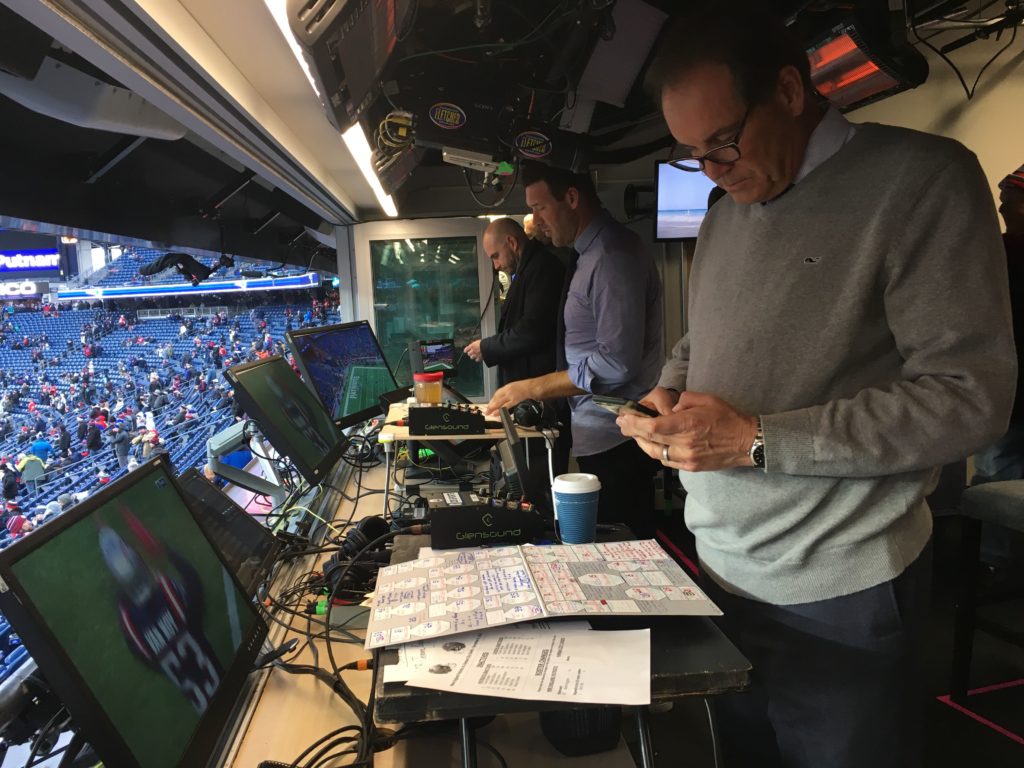
I watch the first half of the game inside the broadcast booth with Nantz and Romo and the second half in the production truck with Rikhoff, director Mike Arnold and their staff. Nantz and Romo often make eye contact while broadcasting the game. Nantz at one point grabs Romo’s hand to remind him to discuss whether he thinks Chiefs quarterback Pat Mahomes is fighting a hand injury. Nantz turns to Romo and talks to him while keeping his eye on a monitor behind Romo. It’s something they talked about in the first year. They want broadcasts to be as much of a conversation as possible.
There are five people at the front of the broadcast booth including Nantz and Romo. Tommy Spencer, who is Nantz’s longtime editorial consultant and spotter, stands to Nantz’s left. To his left is Ethan Cooperson, the traveling statistician for the booth. Brewer is on Romo’s right and there are monitors in front of everyone, including Romo’s “all-22” monitor, which is a wide-angle shot of all 22 players on the field.
Nantz stands for the first half and occasionally puts his foot on the counter next to the monitors, which reveals his black dress socks with a Masters logo. Romo (white tennis shoes) sits for most of the second quarter. The booth gets cold in New England, so McHale set up heaters in advance. Spencer is in motion throughout the game, informing Nantz about who made a tackle or a deflection. Cooperson stays in constant contact via headset with stats editor Thomas Boorstein in the production truck. When Travis Kelce takes a direct snap and runs for a 4-yard touchdown in the second quarter, Cooperson tracks down the last time that had happened. After the commercial break, Nantz says: “Kelce was a wildcat quarterback at the University of Cincinnati and last scored a rushing touchdown in 2009, his freshman season.” That was all Cooperson.
Often the contributions of NFL sideline reporters are subtle. Wolfson might get only six minutes of air time, but she is in constant contact with Rikhoff. She provides a continual stream of injury updates, weather information, and gives Romo and Nantz information from the field level. During a commercial break with 8:46 left in the third quarter, Wolfson tells Rikhoff that Chiefs cornerback Bashaud Breeland was not seriously injured.
“They have spotters in the booth but there is stuff that they can’t see,” Wolfson says. “I am passing a lot of stuff that I see down there and it could just be conversations between the coach and the player. Sometimes there’s stuff that is said that we can’t air it. You cannot air it, but it’s really good stuff. (Browns quarterback) Baker Mayfield came over one time and said, ‘Hey, we got to go hurry up here. We got to go hurry up.’ It’s not something we should be reporting because you’re not supposed to report what they say on the field, but I can say to Tony, “Hey, Tony, expect them to maybe go hurry up here.”
Said Rikhoff: “She’s tenacious, just a really good reporter. She has 50 blue index cards for every game. This is why I really respect what she does. She’s our eyes and ears on the field. She knows sports. She’s journalistically sound. And she’s helped Tony a lot. She always asks questions in our meeting. She’s an integral part of the whole thing.”
Rikhoff is superstitious and a creature of habit. He never eats breakfast before a game and he calls himself a “truck monkey” because he wants to sit in the production truck long before kickoff. “I’ve had a recurring dream that I’ve overslept before a game and I have all the tapes that we need to air and there’s a chain-link fence and I can’t get in,” Rikhoff says.
On Saturday morning, Rikhoff and Arnold visit the stadium to make sure the cameras and production trucks are set up correctly. The CBS group later meets at a hotel with Kansas City head coach Andy Reid and defensive coordinator Steve Spagnuolo, defensive tackle Chris Jones and Mahomes. (Patriots coaches and players were interviewed on Thursday via conference call.)
Saturday afternoon is the production meeting, one of the most important moments of the weekend. About 20 people meet inside a Providence hotel that serves as the broadcast team’s headquarters. To start, Rikhoff gives out two game balls to staffers who excelled the week before.
It’s a 45-minute run-through for game day. Everything is open to discussion, from game-day graphics packages to how the on-air talent will get to the stadium.
Rikhoff gives a synopsis of how the opener of the broadcast is structured, then Josh Cohen, a former quarterback at Dartmouth who works as an editorial consultant, presents “Next Gen Stats,” including one showing Kansas City using pre-snap motion on 66 percent of its plays. The meeting then moves to Katie Keane, whose formal title is broadcast assistant but a more accurate one would be producer of graphics and taped elements. She presents 20 or so graphics for potential use, ranging from big-picture stuff such as the remaining schedule of both teams and a great graphic of the Patriots starting lineup on a roster flip-board featuring the kicking position open. Rikhoff asks Nantz and Romo about each graphic because if they’re not excited about the graphic it’ll come through during the broadcast.
The group moved on to whether they could get in a video clip of Belichick’s famous “We’re onto Cincinnati” clip given New England’s next game was at Cincinnati. (It didn’t make the broadcast.) Near the end of the meeting, Rikhoff asks Romo his thoughts. Romo predicts the Patriots will have success running the football. Nantz and Romo joke about how often Brady’s obit has been written. The mood is light and inviting.
This is Keane’s first year as the graphics lead. She has worked at CBS since graduating from NYU in 2013. She and other members of the production crew, including fellow broadcast associate Ryan Pavlicek, talk early each week to discuss what storylines they want to get on the broadcast in graphic form. Keane has 30 full-page graphics for the Patriots and 25 for the Chiefs as well as 70 additional lower-thirds (filling up just a third of your screen) ready to roll. Most will never air.
“It’s really cool when the room likes it and if it airs on Sunday, that’s the ultimate feeling,” Keane said.
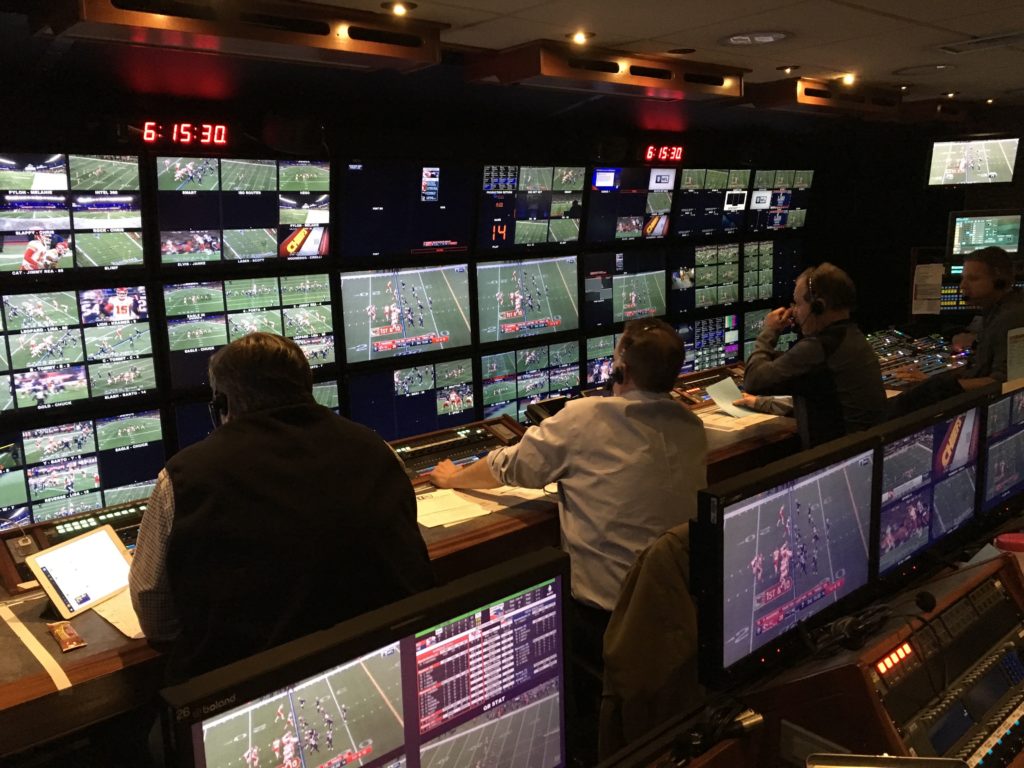
In sharp contrast to the relative calm of the broadcast booth, the control room is organized chaos. There are four CBS broadcast trucks at Gillette Stadium. The A-unit is the main control room, home to 10 key production staffers including Rikhoff, director Arnold, replay producer Ryan Galvin, lead associate director Bryan Kosowski and Kristen Florian, whose job title is director of remote operations planning and production manager. There are about 70-75 people in total working each game.
On every play, Galvin booms out phrases such as “Roll, Eagle,” referring to “Eagle,” one of the replay cameras in a nearby production truck. Depending on the week, between 10-17 people are all talking to Galvin while he maintains a running dialogue with Chris Burns, his associate director.
Galvin watches 23 monitors with every camera angle from the game. The monitors are named after animals – “Leopard,” “Cougar,” “Lion,” and “Rover” – making it easier for Galvin to communicate with the replay specialists in the truck next door. When Galvin screams “Leopard” inside the production truck, a replay from that machine flashes onto the viewer’s TV screen.
Where many lead producers are also in charge of replays, Rikhoff trusts Galvin to handle that aspect of the broadcast. That was established in the first year of this group so Rikhoff could focus more on Romo.
Every camera in the stadium has a number assigned to it and Arnold calls out the camera number (“Take 3 or Take 8”) in the control room to indicate (to the people manning those cameras) what camera he wants to shoot the game at a certain moment. He does this for three-plus hours. It’s exhausting to even watch.
The noise level inside the production truck gets loud on touchdowns or big plays. They make instantaneous decisions on how many replays to show, trying to stay one step ahead of the game action. (Like you, the production team gets ticked off if they can’t show viewers more replays because of things out of their control.) This production team is also aggressive at trying to get packages into the broadcast (such as Next Gen Stats) because Romo really enjoys discussing them. Something else you don’t see at home: Rules official Gene Steratore, who is located at CBS’ New York headquarters, often talks to the booth and the A-unit during breaks to explain his thoughts on penalties or challenges.
In one of the game’s key moments, officials rule Patriots receiver N’Keal Harry stepped out of bounds at the Chiefs’ 3-yard-line with 13:15 left in the fourth quarter. New England is trailing 23-13 and the production truck shows four replays that show Harry did not step out of bounds before crossing the goal line.
Lisa Menzies, one of 10 replay specialists, is monitoring the “Leopard” replay machine. Her cameras, including a reverse angle of all plays and a super slo-mo unit sitting on a cart low on the field, follow the ball. On the Harry play, Menzies tells Galvan that she has something great “because he was running right at me.” Galvin shows viewers the reverse angle, first in real speed and then in super slo-mo. (“That’s a touchdown!” Nantz proclaims to millions of viewers as Harry crosses the goal line.) But the Patriots are out of replay challenges and the play stands as it’s called on the field.
After the game ends, Rikhoff and his group quickly exit the main control room. Everyone looks exhausted. Galvin says he can’t answer questions about the broadcast immediately afterward because his mind is a jumbled mess. He emails me the next day.
“If I’m on the road, I walk through the airport for a while — the calm and silence is the key to bring me back down off of the intensity of the broadcast,” Galvin says. “Without the excellence of all of our technicians, no sports television broadcast is good, let alone great. Rikhoff has taught me one of the many attributes I was missing in order to become a great producer was to ‘enjoy what you’re doing and try and celebrate the moment.’ I texted him after he got the job and said, ‘I’d love to help you as a replay producer for Super Bowl 53.’ He wrote back, ‘I have bigger plans for you.’ I didn’t know it at the time but looking back, this ended up being the best three years of my career. Jim is a leader who isn’t afraid to share the top spot. That’s incredibly rare in this business.”
Rikhoff judges a broadcast on how it covers the big moments. He says he thinks the production and the announcers captured those moments well in New England, especially given the controversial officiating decisions.
“The second half was so frenetic,” Rikhoff says. “The biggest decision we had to make was when do we stay on the field versus showing stuff off the field.”
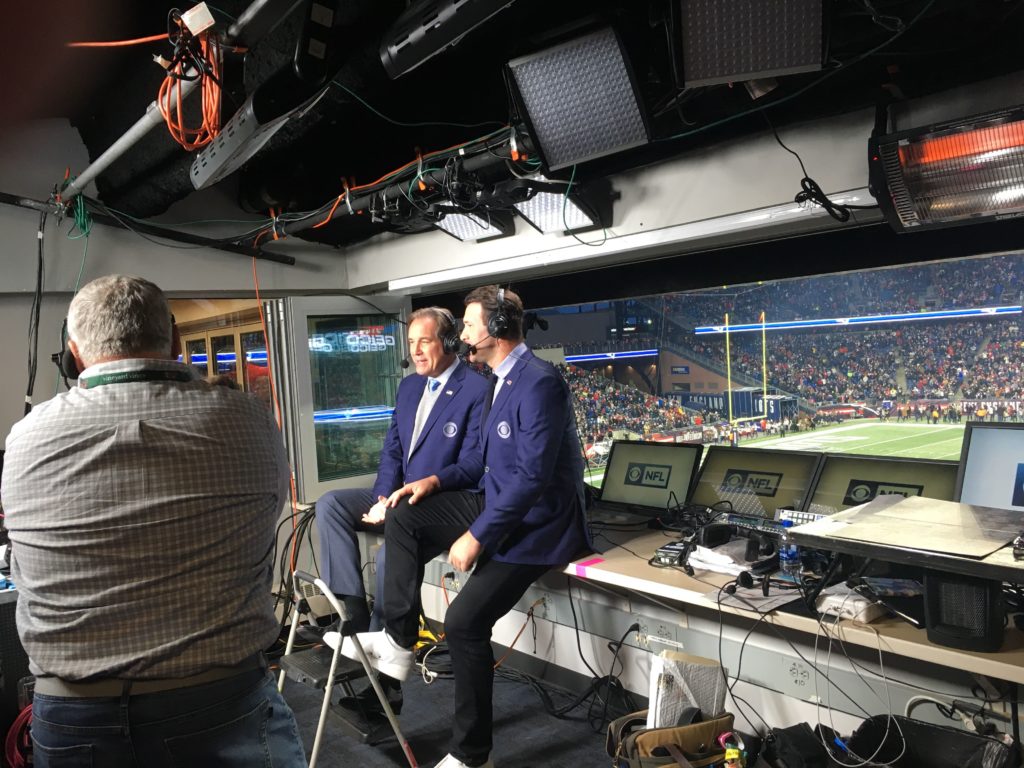
Nantz has talked often about what he thinks is the strength of his partnership with Romo. They were friends before becoming a broadcast team and both agreed they would attempt to create a sound that felt conversational.
“You just connect to somebody, right?” Romo says. “You both like golf? Or you’re both into writing or whatever. Then you start talking and before you know it, they get your jokes when you say them, and they laugh, and they are interested in your story. That was Jim Nantz when I first met him. He loves golf. I love golf. He loves football. I love football. He has a history of knowledge about stuff and stories that can go on forever about stuff I like – Ben Hogan, Ken Venturi, Tiger Woods, Jack Nicklaus, Arnold Palmer. He did all the Peyton Manning-Tom Brady games. And then on top of it, he’s sneaky funny. He has me rolling every week.”
Nantz believes this crew has a chance to be one of the greatest NFL broadcasting teams in history. What he will not do, he says, is recruit Romo to re-sign with CBS when Romo’s contract expires at the end of this season.
“First off, we’re in the middle of the season, so I don’t want to deal with that,” Nantz says. “It’s obviously very personal for him. He’s trying to do what’s best not only for his career but for his family. I don’t think it’s my place to get in the middle of it. So we just march on. We go to our games every week and have a ball.”
What does Romo say about all of this?
“My wife would tell you getting me to commit to something two weeks from now is a difficult proposition,” he says. “More than anything, I love our team. Jim Rikhoff is rare and special… (Who) wouldn’t want to be with Jim Nantz forever. I know how talented and gifted he is and I also know how close a friend he is. That’s a gift.”
Adds Nantz: “If we could get 15 years, that would be a career goal for me. That would cover five or six Super Bowls in that span. I am 60 and Tony is not even 40 yet. He turns 40 in April. He’s like three years younger than Tom Brady! At that point, I would be 75. How I would love to be able to play this out for a generation of games together.”
(Photos: Richard Deitsch / The Athletic)
Source link

